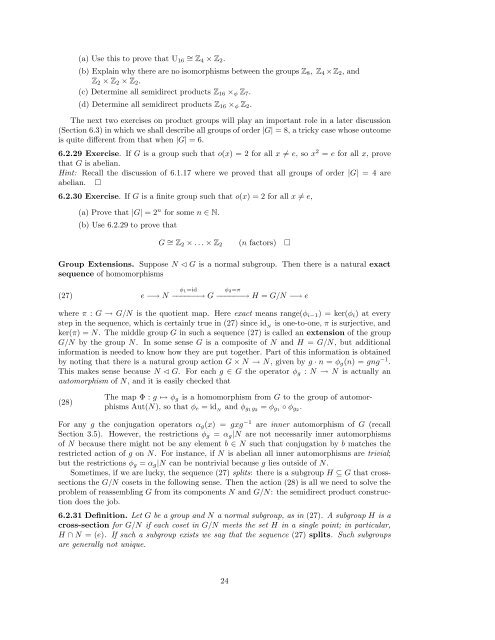Algebra I: Section 6. The structure of groups. 6.1 Direct products of ...
Algebra I: Section 6. The structure of groups. 6.1 Direct products of ...
Algebra I: Section 6. The structure of groups. 6.1 Direct products of ...
You also want an ePaper? Increase the reach of your titles
YUMPU automatically turns print PDFs into web optimized ePapers that Google loves.
(a) Use this to prove that U16 ∼ = Z4 × Z2.<br />
(b) Explain why there are no isomorphisms between the <strong>groups</strong> Z8, Z4 ×Z2, and<br />
Z2 × Z2 × Z2.<br />
(c) Determine all semidirect <strong>products</strong> Z16 ×φ Z7.<br />
(d) Determine all semidirect <strong>products</strong> Z16 ×φ Z2.<br />
<strong>The</strong> next two exercises on product <strong>groups</strong> will play an important role in a later discussion<br />
(<strong>Section</strong> <strong>6.</strong>3) in which we shall describe all <strong>groups</strong> <strong>of</strong> order |G| = 8, a tricky case whose outcome<br />
is quite different from that when |G| = <strong>6.</strong><br />
<strong>6.</strong>2.29 Exercise. If G is a group such that o(x) = 2 for all x �= e, so x 2 = e for all x, prove<br />
that G is abelian.<br />
Hint: Recall the discussion <strong>of</strong> <strong>6.</strong>1.17 where we proved that all <strong>groups</strong> <strong>of</strong> order |G| = 4 are<br />
abelian. �<br />
<strong>6.</strong>2.30 Exercise. If G is a finite group such that o(x) = 2 for all x �= e,<br />
(a) Prove that |G| = 2 n for some n ∈ N.<br />
(b) Use <strong>6.</strong>2.29 to prove that<br />
G ∼ = Z2 × . . . × Z2<br />
(n factors) �<br />
Group Extensions. Suppose N ⊳ G is a normal subgroup. <strong>The</strong>n there is a natural exact<br />
sequence <strong>of</strong> homomorphisms<br />
(27) e −→ N φ1=id<br />
−−−−−−→ G φ2=π<br />
−−−−−−→ H = G/N −→ e<br />
where π : G → G/N is the quotient map. Here exact means range(φi−1) = ker(φi) at every<br />
step in the sequence, which is certainly true in (27) since id N is one-to-one, π is surjective, and<br />
ker(π) = N. <strong>The</strong> middle group G in such a sequence (27) is called an extension <strong>of</strong> the group<br />
G/N by the group N. In some sense G is a composite <strong>of</strong> N and H = G/N, but additional<br />
information is needed to know how they are put together. Part <strong>of</strong> this information is obtained<br />
by noting that there is a natural group action G × N → N, given by g · n = φg(n) = gng −1 .<br />
This makes sense because N ⊳ G. For each g ∈ G the operator φg : N → N is actually an<br />
automorphism <strong>of</strong> N, and it is easily checked that<br />
(28)<br />
<strong>The</strong> map Φ : g ↦→ φg is a homomorphism from G to the group <strong>of</strong> automorphisms<br />
Aut(N), so that φe = id N and φg1g2 = φg1 ◦ φg2.<br />
For any g the conjugation operators αg(x) = gxg −1 are inner automorphism <strong>of</strong> G (recall<br />
<strong>Section</strong> 3.5). However, the restrictions φg = αg|N are not necessarily inner automorphisms<br />
<strong>of</strong> N because there might not be any element b ∈ N such that conjugation by b matches the<br />
restricted action <strong>of</strong> g on N. For instance, if N is abelian all inner automorphisms are trivial;<br />
but the restrictions φg = αg|N can be nontrivial because g lies outside <strong>of</strong> N.<br />
Sometimes, if we are lucky, the sequence (27) splits: there is a subgroup H ⊆ G that crosssections<br />
the G/N cosets in the following sense. <strong>The</strong>n the action (28) is all we need to solve the<br />
problem <strong>of</strong> reassembling G from its components N and G/N: the semidirect product construction<br />
does the job.<br />
<strong>6.</strong>2.31 Definition. Let G be a group and N a normal subgroup, as in (27). A subgroup H is a<br />
cross-section for G/N if each coset in G/N meets the set H in a single point; in particular,<br />
H ∩ N = (e). If such a subgroup exists we say that the sequence (27) splits. Such sub<strong>groups</strong><br />
are generally not unique.<br />
24

















